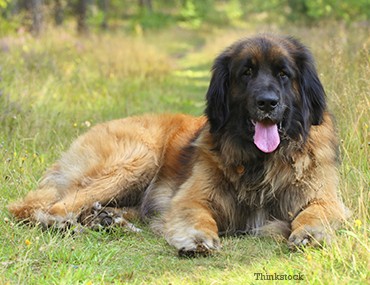Background
The Loenberger takes his name from his home town of Leonberg, Germany, where he first emerged during the 1800s. In the beginning he worked as a family and work dog, but the breed got so much attention from German artists that they often traded in these mundane tasks for the glamorous life of art models. Many parts of Europe embraced the trend and the Loenberger’s face wound up on several stamps of that time period.
The Leonberger was recognized by the American Kennel Club in 2010.
Sizing up
- Weight: 120 to 170 lbs.
- Height: 25.5 to 31.5 inches
- Coat: Double coat, medium to long in length
- Color: Lion yellow and golden or reddish-brown
- Life expectancy: 6 to 9 years
What’s the Leonberger like?
The Leonberger, while possibly intimidating, is very sweet. He is loyal, loveable, and very active. He will need plenty of daily exercise whether it’s going hiking or for a nice, long walk. But just because he enjoys the outdoors doesn’t mean he likes to be left alone out there—or anywhere. The Leo is extremely infatuated with his family and does not like to be away from them for long periods of time.
Training your Leo should begin right away if you want him to have the gentle traits that his breed is so well known for. Otherwise, he can be quite the handful. Socialization at an early age is also very important. You’ll need to be firm and consistent throughout all of it because he will test you when you let him. Make sure he knows you’re the alpha. Using positive reinforcements and food rewards will be integral to the process. If you follow this advice, your Leo will make a great friend for children.
The massive Leonberger has a lot of fur, so he will shed more frequently than your average dog. You’ll need to give him a very thorough brushing to remove any dead hairs before they end up on your furniture. He loves getting dirty so keeping up with regular baths will help his coat look extra shiny and beautiful.
Health
Larger breeds, like the Leonberger, are at a greater risk for several conditions.
Hip Dysplasia
- One of the most common diseases seen in dogs, with larger breeds being the most affected. It is ultimately a malfunction of the hip joints
- The development of arthritis in the elbow joint
- A disease caused by a decrease in metabolism due to an under-active thyroid hormone
- A condition in which a dog's stomach rotates and twists; in some cases it can lead to cellular damage or organ death
- A condition common to medium or large sized dogs that affects the bones in their legs causing a painful limping. Usually seen around 5 to 18 months of age
- The most common bone tumor found in dogs. It is usually seen in larger breeds and can spread rapidly throughout the dog’s body
Takeaway points
- The Leonberger would make a great hiking companion.
- The Leonberger is an excellent watchdog.
- The Leonberger can be great with children as long as they’re respectful.
- The Leonberger tends to shed a lot.
If you have any questions or concerns, you should always visit or call your veterinarian -- they are your best resource to ensure the health and well-being of your pets.
